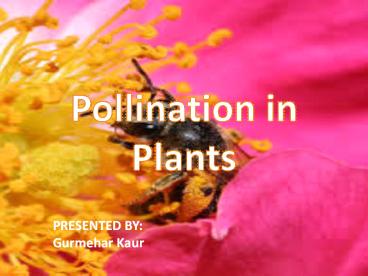Agents of Pollination - PowerPoint PPT Presentation
Title:
Agents of Pollination
Description:
how pollen is transported from one flower to another by the agents of pollination – PowerPoint PPT presentation
Number of Views:4009
Updated: 2 July 2016
Slides: 16
Provided by:
Username withheld or not provided
Category:
Medicine, Science & Technology
Tags:
Title: Agents of Pollination
1
Pollination in Plants
PRESENTED BY Gurmehar Kaur
2
Agents of Cross-Pollination
- A pollinator is any agent that transfers pollen
from male to female reproductive parts of flowers
of the same plant species. - The two commonest agents of cross-pollination are
insects and wind. But, some flowers are also
pollinated by certain animals and birds, like
squirrels, bats, etc., or even by water in the
case of some aquatic plants. Each category has
some special features to promote changes of
pollination.
3
Pollination Agents
Biotic factor
Abiotic factor
Birds
Wind
Insects
Bats
Water
4
Wind Pollination
- Wind Pollination. Wind pollination (also called
'Anemophily') describes the process of the
transfer of pollen from one individual plant to
another, whereby the pollen is carried by air
currents. Plants may be non-flowering common in
grasses and grains, or flower-producing.
5
Wind pollinated flowers usually posses the
following special features
- The flowers are small.
- They are usually not brightly coloured and often
dull green. - They do not produce scent or nectar.
- The stamens are long and hang out of the flower
to be exposed to air. - The anthers are large and loosely attached to the
filaments so that the slightest wind may move
them. - Pollen is produced in very large quantities.
- Pollen grains are light, dry and smooth so that
they can easily be carried away by wind. - The stigma are feathery and hang out of the
flower to tap the pollen grains.
6
(No Transcript)
7
Examples of Wind Pollinated PLANTS
- Wheat
Grasses
Catkins
Maize
8
Insect pollination
- Many insects visit flowers for nectar. During the
process some pollen sticks to the body parts of
these insects and when this insect visits another
flower the pollen grains are brushed off, some of
which fall on the stigma and thus pollination
takes place. - Hence we conclude that insect pollination is a
type of pollination in which the pollen is
transferred from one insect to another by
insects. - Its estimated that over 84 of crops in Europe
are dependent upon insect pollination.
9
Insect pollinated flowers usually posses the
following special features
- The flowers are large.
- They are usually brightly coloured to attract
insects. - They usually emit scent for attracting insects.
- They produce nectar which is food for the
insects. - The pollen grains are sticky or spiny to enable
them to be carried by insects easily. - The stigma is sticky and does not generally hang
out from the flower.
10
Examples of Insect Pollinated plants
- Lobelia siphilitica
Lemon Bee Balm
Common Evening Primrose
11
Water pollination
- Pollination in aquatic plants is usually carried
out by water. Water pollinated flowers release
there pollen grains into the water and are
passively carried to other plants by water
currents.
(b)
(a)
These male (a) and female (b) catkins from the
goat willow tree (Salix caprea) have structures
that are light and feathery to better disperse
and catch the wind-blown pollen.
12
Water pollinated flowers usually posses the
following special features
- Pollen grains are produced in large numbers.
- In some plants the pollen grains have a specific
gravity almost equal to that of water so that
they remain floating below the surface of water. - In some special cases male flowers are such that
they float on the surface of water till they meet
female flowers e.g. Vallisneria.
13
Examples of Water Pollinated plants
- Eel-grass
Hydrilla
Coontail
14
Something More
- Some flowers are pollinated by birds
(ornithophily, ornitho bird), e.g. Bignonia,
canna - Elephophily is the pollination affected by
elephants. Elephophily is found in Rafflesia
whose flowers are very large and are found at
ground level. The pollen grains of one flower get
attached to the feet of elephants and may be
carried to the stigma of another flower when
trampled by those feet.
15
(No Transcript)































